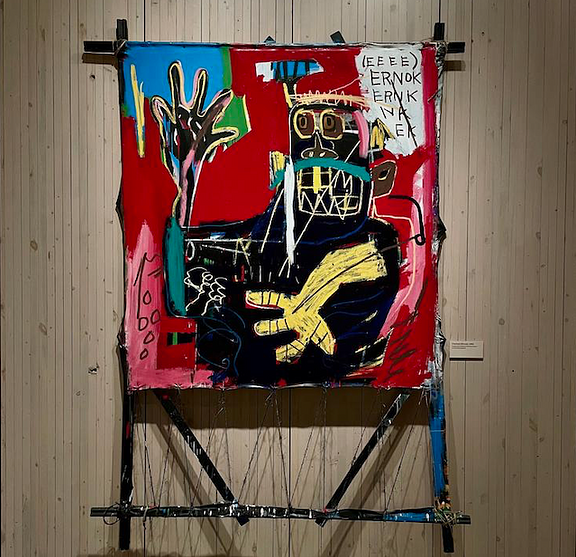LA
Basquiat’s Final Studio Travels From Coast To Coast
by | Nov 28, 2023 10:49 am
Post a Comment | E-mail the Author
Posted to: Visual Art

JEAN-MICHEL BASQUIAT: King Pleasure
The Grant
Los Angeles
Through Jan. 1, 2024
The opening walkway of the Jean-Michel Basquiat: King Pleasure exhibit at the Grand LA is printed with the milky splash of a composition notebook. Near the entrance: A life-size image of the artist, his face tilted up to the sky, closed eyes bathed in light. The greeting feels perfect and — considering Basquiat’s tumultuous struggle with talent, fame, and authenticity — heartbreaking.
This evocative power extends into the first gallery, the most extensive of the exhibit’s four. There, the corridor is donned with scrap paper and pages from Basquiat’s notebooks covered in acrylic, oil stick, and crayon drawings. (One can hardly help imagining him sketching in coffee shops, his kitchen, hungover in bed.) Among a comprehensive collection of other pieces, the room also features two prominent images: one of Basquiat’s iconic untitled skull paintings, and a silkscreen-on-canvas portrait of the artist by Andy Warhol. Set facing each other, these two pose a stark reminder of the tightrope the artist walked between the ever personal and often external motivations for his work, between the permanent and the ephemeral.
King Pleasure debuted in New York in April 2022. Since the end of March 2023, the exhibit has graced Downtown Los Angeles to much acclaim. Originally slated to run until the end of July, it has been extended for the rest of the year. Perhaps this isn’t a surprise. By featuring over 200 pieces that have rarely or never before been seen, the curators — the artist’s sisters and the administrators of his estate, Lisane Basquiat and Jeanine Heriveaux — offer a deeply moving look at key moments of the Neo-expressionist street artist’s life.
The second gallery houses a replica of Basquiat’s final studio at 57 Great Jones Street in Lower Manhattan. The front entryway represents a scaled-down version of the building’s facade; the artist’s actual bike is propped against the front window. Inside: His painted refrigerator door, a wall of collectibles (like gifts from friends), notebooks he kept with Andy Warhol, and keepsakes from his travels to Africa. The installation culminates in a recreation of his studio space — jazz records on the floor, VHS copies of Sixteen Candles and The Outsiders near a tube TV, and dozens of original pieces, including a Charlie Parker – inspired painting, Charles the First(1982). It’s a small but powerful glimpse of the impressive variety of music, art, and pop culture that Basquiat regularly engaged with — not to mention, permanently contributed to.
The last two galleries provide a fitting conclusion to this immersive exhibit. The third is a single room with three walls featuring pieces mostly dedicated to or inspired by one of the artist’s musical icons, aforementioned jazz great Charlie Parker. Parker’s turbulent personal life — as well as his nearly supernatural influence on music, art, and Basquiat himself — offers an apt parallel and closing movement as visitors near the fourth and final gallery. That gallery is another replica: one of the VIP room at an ’80s NYC nightclub, the Palladium. Complete with framed broken mirrors, stacked television sets, and the original larger-than-life Basquiat pieces that were hung on the club’s walls, this last installation represents a potent, if not uplifting, end to the journey. Highlighting the lasting impact of his legacy on his family, Brooklyn, American aesthetics, and the entire art world, King Pleasure reminds us of the artist’s almost unbelievable influence. Like career, like exhibit: Exceptional.